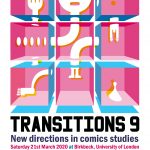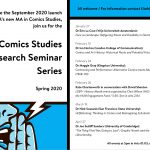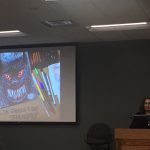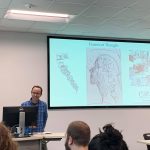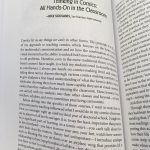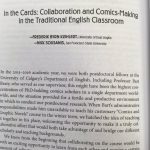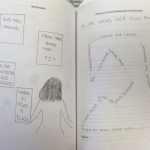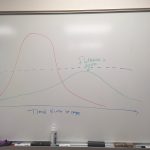Some speaking news, publication announcements, and down below, a new collaborative (!) comics-making challenge! (scroll to bottom if you want to start with that!)
First, I was set to go to the UK next week for a series of talks and workshops – including keynoting the Transitions comics conference in London and giving a workshop alongside graphic medicine expert Ian Williams, a visit to University of East Anglia, where my colleague Frederik Køhlert is launching a comics studies masters program(!), and would’ve gone up to Newcastle, to be with comics folks at Northumbria University. Given the situation in San Francisco and globally, it was not a responsible decision to travel – so with great regrets, I had to cancel my attendance (and as the situation has worsened, Transitions was canceled entirely for this spring). A lot of planning and effort went into this over the past year from Frederik Køhlert, Hallvard Haug, John Meiers, Mel Gibson, and others – and I was eagerly looking forward to the opportunity and to finally getting to meet so many people I’ve connected through their work and social media. But these are difficult times.
I was at Michigan State to keynote their annual comics forum last month (alongside rock star Monster cartoonist Emil Ferris!) – it was a wonderful event, and the kind folks there livestreamed and archived the entire keynote address. You can find Emil’s and my talks here, or mine directly on youtube here. Organizer Ryan Claytor did a nice wrap-up of the event here. It was really a great gathering all around, and nice to be in my home state and have my family and old friends show up as well! The talk touched on Unflattening, delved into my process, went into some detail on my teaching, and gave some sneak previews of the new book Nostos. So if you’re so inclined, have a look here.
On the subject of teaching, I’ve got two chapters in the new book on teaching with comics “With Great Power Comes Great Pedagogy.” First, a chapter that details how I came to my hands-on approach of teaching comics, which also details many of the exercises and activities I do in my classes. (Many of these activities are documented with tons of student examples on my site here.) And next, I’ve co-authored a chapter with Frederik Køhlert on our experience co-teaching a comics course, and the activities we came up with together to do hands-on activities in a large, lecture-format course. This includes our take home midterm, which is also documented here. The book has interviews with creators including Lynda Barry, Brian Michael Bendis, and Kelly Sue DeConnick, and contributions from colleagues Bart Beaty, Leah Misemer, Ebony Flowers, and many more really terrific scholars – all put together by Susan Kirtley, Antero Garcia, and Peter E. Carlson. Have a look here, and the Comics Grid has an early review. (You can see my recent drawn syllabi in my last post here.)
Finally, as I prepare to take my classes online and figure out ways to still have them be as interactive and collaborative as they are in person, I wanted to test out a new comics-making challenge, along the lines of ones I’ve offered on Twitter in year’s past. I’ve been doing my non-representational comics-making exercise Grids and Gestures in classes and talks for years now, and these few times on Twitter. (As a related aside, you can see how comics teacher Nicolas Verstappen modified this in a powerful way with his students here.)
Here’s the plan for the challenge:
Warmup: Tuesday, March 17, people do Grids and Gestures and post to twitter hashtag #gridsgestures (can tag me too, @nsousanis). The short version of Grids and Gestures is organize a single sheet of paper in some grid-esque fashion to capture the shape of your experiences over a single day, and inhabit that with lines, marks, gestures that represent what you were up to or how you felt throughout the day. You can see the full instructions, including a video of me explaining it here.
- 3-person collaborative comic
3-Person Collaborative Comics-Making!
Wednesday, March 18. Step 1: Person draws a blank page composition/panel layout – of at least some complexity (say, more than a four panel regular grid, probably more than a 6 panel, but you can vary that). If this were in a class, each person would have about two minutes to do this and then pass to the next person. For trying it online, when you’ve finished, POST to twitter #collabcomics with your handle on a tiny corner of the page (can tag me as well).
Thursday, March 19. Step 2: Claim someone else’s blank composition and then put in the words and the word supports (captions, word balloons, thought bubbles), or sound effects. (Thinking about leaving space for characters, drawing, etc.) This step is usually about seven minutes in class. But again, for online, when finished, POST to twitter #collabcomics, tag the first person as well when you post.
Friday, March 20. Step 3: Claim a fully lettered page, and then draw everything that goes on in the comic. In class and workshops, this is usually 10-15 minutes, sometimes it’s a take-home. (I have done this with the drawing being second – it is for reasons I can speculate on, not as successful.) When finished, POST to #collabcomics with the names of all previous collaborators. Enjoy and marvel at all the finished collaborative comics by following the hashtag #collabcomics! (The example above was the best one of these I’ve ever seen – just a great comic all on its own. It was done by students in my Comics as a Way of Thinking class back at the University of Calgary, and documented here.)
In my classes, I’ve found there’s something almost magical about how the disparate elements come together with these, and I think it speaks the importance of constraints and collaboration to accelerate the creative process. These fast switches, dividing up the labor – frees them from having to think of something perfect that they’ve invested too much in – they can get their hands moving and thus their minds working and the results are frequently thrilling. And the energy in the classroom while they’re doing this is such a treat to behold. I hope you give it a try and spread the word – really curious to see how this works in an online environment. All things about my teaching along with student examples are online in the Education part of this site here.
To wrap, when I first saw the diagram about “flattening the curve” to slow the outbreak of covid-19, it really left an impression on me and I’ve since drawn it for my students and in the air for anyone I happen to be talking to. It’s really important to understand why social distancing is key in this uncertain moment. Have a read about that curve here. In the meantime, be safe and stay healthy. Hope to see some of you sharing your collaborative comics soon… – Nick


